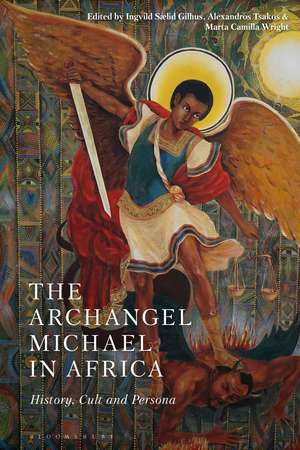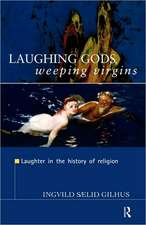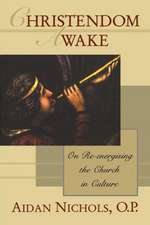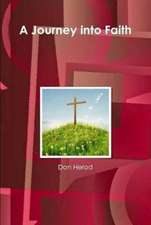The Archangel Michael in Africa: History, Cult and Persona
Editat de Ingvild Saelid Gilhus, Alexandros Tsakos, Marta Camilla Wrighten Limba Engleză Paperback – 24 feb 2021
| Toate formatele și edițiile | Preț | Express |
|---|---|---|
| Paperback (1) | 218.18 lei 6-8 săpt. | |
| Bloomsbury Publishing – 24 feb 2021 | 218.18 lei 6-8 săpt. | |
| Hardback (1) | 775.83 lei 6-8 săpt. | |
| Bloomsbury Publishing – 7 aug 2019 | 775.83 lei 6-8 săpt. |
Preț: 218.18 lei
Preț vechi: 275.15 lei
-21% Nou
Puncte Express: 327
Preț estimativ în valută:
41.79€ • 43.05$ • 35.00£
41.79€ • 43.05$ • 35.00£
Carte tipărită la comandă
Livrare economică 24 februarie-10 martie
Preluare comenzi: 021 569.72.76
Specificații
ISBN-13: 9781350242678
ISBN-10: 1350242675
Pagini: 264
Dimensiuni: 156 x 234 x 19 mm
Greutate: 0.37 kg
Editura: Bloomsbury Publishing
Colecția Bloomsbury Academic
Locul publicării:London, United Kingdom
ISBN-10: 1350242675
Pagini: 264
Dimensiuni: 156 x 234 x 19 mm
Greutate: 0.37 kg
Editura: Bloomsbury Publishing
Colecția Bloomsbury Academic
Locul publicării:London, United Kingdom
Caracteristici
Brings together traditional religious studies methodologies with innovative perspectives from memory studies, art education, and semiotics
Notă biografică
Ingvild Sælid Gilhus is Professor in the Study of Religion at the University of Bergen, Norway. Alexandros Tsakos is Scientific Director of the Collection of Manuscripts and Rare Books of the Special Collections of the University Library of Bergen, Norway. Marta Camilla Wright is a PhD student in the Study of Religion at the University of Bergen, Norway.
Cuprins
List of FiguresList of MapsAcknowledgementsNotes on ContributorsPart One: On Angels and Michael in Africa1. The African Context, Alexandros Tsakos (University of Bergen, Norway)2. On the Category of Angels, Ingvild Sælid Gilhus (University of Bergen, Norway)3. Michael: Persona and Cult Among African Christians, Marta Camilla Wright (University of Bergen, Norway)Part Two: The Archangel Michael in Coptic EgyptIntroduction: Christian Egypt, Ingvild Sælid Gilhus (University of Bergen, Norway)4. The Archangel Michael as Psychopomp in Christian Iconography in Egypt, Karel Innemée (University of Amsterdam, the Netherlands)5. On the Liturgical Memories of the Archangel Michael in the Coptic Church and their Link with the Nile's Rise: Some Reflections, Pietro D'Agostino (Paris-Sorbonne University, France)6. Textual Fluidity and Monastic Fanfiction: the Case of the Investiture of the Archangel Michael in Coptic Egypt, Hugo Lundhaug (University of Oslo, Norway) Part Three: The Archangel Michael in Christian NubiaIntroduction: Christian Nubia, Alexandros Tsakos (University of Bergen, Norway)7. Representations of the Archangel Michael in Wall Paintings from Medieval Nubia, Dobrochna Zielinska (University of Warsaw, Poland) and Alexandros Tsakos (University of Bergen, Norway)8. The Position of the Archangel Michael within the Celestial Hierarchy: Some Aspects of the Manifestation of his Cult in Nubian Painting, Magdalena Laptas (Cardinal Stefan Wyszynski University in Warsaw, Poland)Part Four: The Archangel Michael in Christian EthiopiaIntroduction: Christian Ethiopia, Marta Camilla Wright (University of Bergen, Norway) 9. Relationships with the Archangel Michael: Materiality and Healing Among Ethiopian Orthodox Christians in Contemporary Addis Ababa, Marta Camilla Wright (University of Bergen, Norway)10. The Archangel Michael: An Everyday Popular Saint in Ethiopia, Dan Levene (University of Southampton, UK)Part Five: The Archangel Michael in South AfricaIntroduction: South Africa, Lize Kriel (University of Pretoria, South Africa) 11. "Branded" St. Michael: A View from Pretoria on the Archangel's Position in South African Consumer Culture, Lize Kriel (University of Pretoria, South Africa)12. The Presence and Absence of the Archangel Michael in South Africa, Deléne Human (University of Pretoria, South Africa)13. The Archangel Michael in Limpopo: The Sculptor Jackson Hlungwani and the Angel-Star of the Ngoma Lungundu Epic, Raita Steyn (University of Pretoria, South Africa)Appendix: Some Thoughts on How I Came to Michael, Or How He Came to Me by David Tibet (Independent Researcher)BibliographyIndex
Recenzii
The book is a great resource and introduction to a more or less unfamiliar religious phenomenon in Africa... Except for chapters on South Africa, the book is a presentation of a broad interdisciplinary study of the contextualization of non-Chalcedonian Christianity in terms of both spatial and temporal width. The book is essential for students of African Christianity, as for students of religion and art in an African context.
This book is a tremendous resource for understanding the diversity of Michael veneration in ancient and modern African Christianity. It is also a significant advancement in the study of the origins of Michael veneration, aswell as in his enduring popularity. The collected essays offer insight into late antique conceptions of the archangel, ways of representing Michael in the Middle Ages, and Michael's appearances in present-day African cultures.
This collection of essays presents intriguing analyses of the roles and function of Michael the Archangel within African Christianities. The interplay of textual, visual, oral, and archaeological evidence sheds light on this heavenly figure of importance of importance to not only the medieval Coptic Church of Egypt and Nubia, but also the contemporary the Ethiopian Orthodox Church and more recent faith movements in South Africa. Anglophone readers will find a world but rarely encountered.
This book is a tremendous resource for understanding the diversity of Michael veneration in ancient and modern African Christianity. It is also a significant advancement in the study of the origins of Michael veneration, aswell as in his enduring popularity. The collected essays offer insight into late antique conceptions of the archangel, ways of representing Michael in the Middle Ages, and Michael's appearances in present-day African cultures.
This collection of essays presents intriguing analyses of the roles and function of Michael the Archangel within African Christianities. The interplay of textual, visual, oral, and archaeological evidence sheds light on this heavenly figure of importance of importance to not only the medieval Coptic Church of Egypt and Nubia, but also the contemporary the Ethiopian Orthodox Church and more recent faith movements in South Africa. Anglophone readers will find a world but rarely encountered.





















